Mental Health Statistics: In recent years, there has been increasing acknowledgment of the important role mental health plays in achieving global health development goals.
Mental health statistics will help you to get detailed insights about what is the importance of mental health and how mental health disorders’ prevalence is increasing among individuals across the globe.
Depression is one of the major leading causes of mental disorders. Suicide is the fourth leading cause of death among 15-29 years old individuals. Despite progress in some countries, people with mental health conditions often experience severe human rights violations, stigma, and discrimination.
Mental health conditions are increasing worldwide. Mainly due to demographic changes, there has been a 13% rise in mental health conditions and substance use disorders in the last few decades.
Table of Contents
- Importance of Mental Health
- Top Key Mental Health Statistics
- Mental Health Statistics – AMI
- Mental Health Services- SMI
- Common Mental Health Illness
- Women’s Mental Health
- Global Consumer Spends On Mental Wellness
- Mental Health Status in Asia
- Mental Health Treatment in the US
- Psychotic Disorders Worldwide
- Mental Health Services Challenges in Canada
- Mental Health Practices of Gen Z in Russia 2022
- COVID-19 Impact on Mental Health Statistics
- Recent Developments
- Wrap Up
- FAQs
Importance of Mental Health
Mental health is essential to our well-being and quality of life. It refers to our psychological, emotional, and social well-being and affects how we think, feel, and behave.
Mental health plays an important role in our ability to cope with stress, form relationships, and make decisions.
Poor mental health can contribute to physical health problems such as heart disease, high blood pressure, and chronic diseases.
Take advantage of our unbeatable offer - buy now!

The prevalence of mental health disorders is increasing worldwide due to changing lifestyles, thus to overcome such issues it is necessary to cope with mental health.
Common Mental Health Illness
- Depression
- Anxiety/Phobias
- Eating Disorders
- Stress
Severe Mental Health Illnesses
- Schizophrenia
- Bipolar disorder (Manic depression)
- Clinical depression
- Suicidal tendency
- Personality disorder
Top Key Mental Health Statistics
- Global AI in Mental Health Market size is expected to be worth around USD 14.89 Billion by 2033 from USD 0.92 Billion in 2023, growing at a CAGR of 32.1% during the forecast period from 2024 to 2033.
- Around 20% of the world’s children and adolescents have a mental health condition.
- Suicide is the leading cause of death among individuals aged 15-29 years.
- About 1 in 5 people have post-conflict mental health conditions.
- The global median of government health expenditure that goes to mental health is less than 2%.
- The two most common health conditions are depression and anxiety.
- The cost of the global economy is USD 1 trillion each year.
(Source: who)

Prevalence of Any Mental Illness (AMI)
- More than 57.8 million adults aged 18 or older in the United States have Any Mental Illness in 2021.
- The prevalence of AMI is more (27.2%) in females.
- 18.1% of males have any mental illness which is comparatively less than females.
- 33.7% of young adults aged 18-25 years had the highest prevalence of AMI.
- 28.1% of adults aged 26-49 years have AMI.
- 15% of individuals aged more than 50 years have Any Mental Illness.
- The prevalence of AMI was highest among adults reporting two or more races (34.9%).
- 26.6% of American Indian/Alaskan Native adults have AMI.
- 16.4% of Asian adults have AMI.
(Source: nimh.nih)
Mental Health Statistics – AMI
- In 2021, 52.8 million adults with Any Mental Illness, and 26.5 million adults received mental health services.
- 61.7% of females with AMI received mental health services.
- 40% of males received mental health services in the past year.
- 44.6% of young adults aged 18-25 with AMI received mental health services in 2022.
- 48.1% of adults aged 26-49 years with AMI received mental health services in the past year.
(Source: nimh.nih)
Prevalence of Serious Mental Illness (SMI)
- 14.1 million adults aged 18 or older in the United States have Serious Mental Illness.
- SMI prevalence is high among females (7.0%) as compared to males (4.0%).
- Young adults aged 18-25 years had the highest prevalence of SMI which is about 11.4% compared to adults aged 26-49 years (7.1%).
- 9.3% of American Indian/Alaskan Native adults have SMI.
- 8.2% of adults with two or more races have SMI.
- The prevalence of SMI among Asian adults is comparatively low (2.8%).
(Source: Nimh.nih)
Mental Health Services- SMI
- In 2021, more than 14.1 million adults with SMI received mental health treatment.
- More than 67.6% of females get mental health treatment in the past year which is comparatively more than males (61.3%).
- 57.9% of adults aged 18-25 years get SMI mental health treatment.
- 67% of adults aged 26-49 years received mental health treatment in 2021.
(Source: Nimh.nih)
Common Mental Health Illness
- More than 970 million individuals worldwide have substance abuse disorder.
- Anxiety is the most common mental health issue across the globe. More than 284 million individuals are affected with anxiety.
- Mental health illness is high among females as compared to males.
- Mental health disorders cause 14.3% of deaths worldwide each year.
(Source: single care)
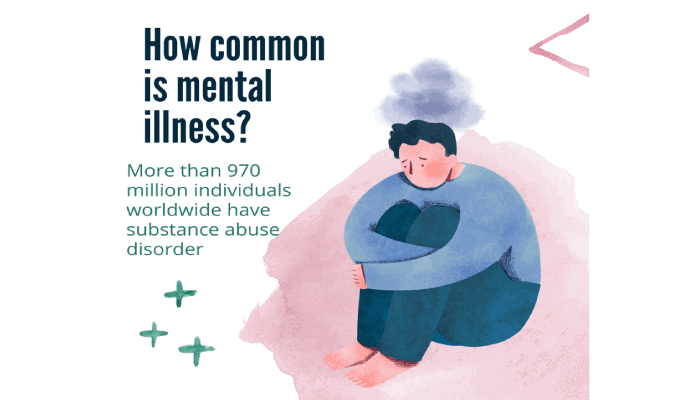
Women’s Mental Health
- 1 in 5 women has a serious mental health disorder.
- 26% of young women aged 16-24 years old reported that they have a common mental health disorder.
- Women are more likely to be affected by depression than men.
- About 53% of women have mental health problems.
- 44% of women are currently facing the problem of anxiety, and 38% of women are battling body image issues.
- 1 in 5 girls in their teenage years have an eating disorder.
- More than 20% of women are facing infertility/fertility challenges.
- More than 23% of women are suffering from perinatal depression and anxiety.
(Source: liptemberfoundation)

Women’s Mental Health in India
- 41.9% of women in India are facing depressive mental disorder.
- Leading mental health problems among women who are elderly are depression, organic brain syndromes, and dementia in India.
- The lifetime prevalence rate of violence against women ranges from 16% to 50%.
- At least 1 in 5 women suffers rape or attempted rape in their lifetime.
- According to the Indian government 2.9% of women suicide due to dowry disputes compared to men (0.2%).
- 15.4% of women’s suicides are due to love affairs in India.
- 10.3% of women’s suicide due to illegitimate pregnancies.
- The common cause of suicide in India is disturbed interpersonal relationships followed by psychiatric disorders and physical illnesses.
- 70% of married women between the ages of 15 and 49 are victims of beating, rape, or coerced sex.
- The common violence against Indian females includes dowry death, domestic violence, mental and physical torture, public humiliation, and sexual trafficking.
- 30% of women’s reported sexual coercion.
(Source: liptemberfoundation)
Opinion On the Importance of Mental and Physical Health in India 2022 Statistics
- According to a survey conducted in 2022 by Ipsos, about 27% of the public believed that mental health is treated as more important than physical health in India.
- Whereas, 35% of respondents thought that mental and physical health were treated as equally important.
(Source: Statista)
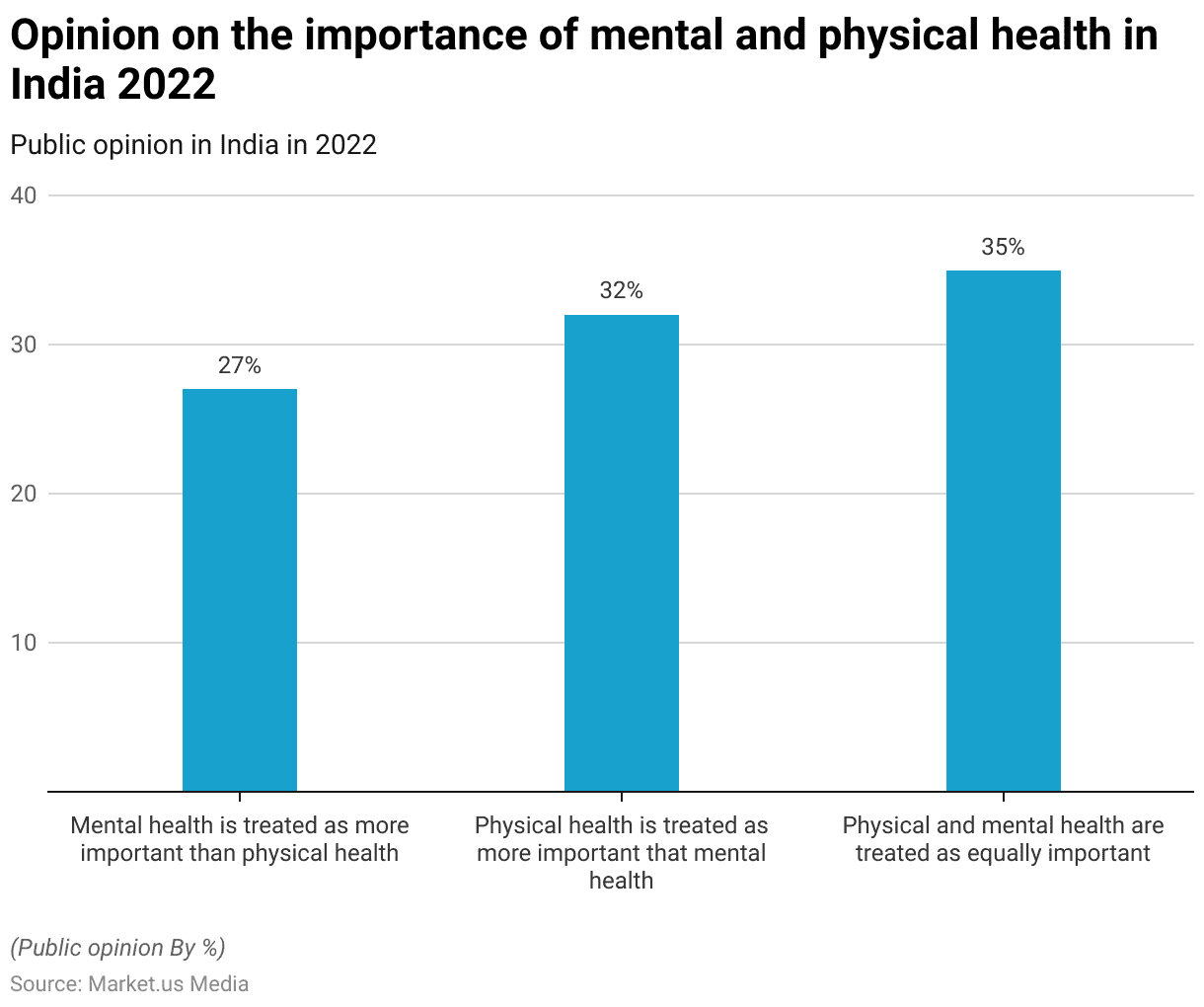
Global Consumer Spends On Mental Wellness
- In 2022, global consumer spending for mental wellness apps reached almost USD 270 million as compared to the previous year.
- In 2022, mobile mental wellness apps generated revenue of USD 491 million in consumer spending, up by 82.5% compared to 2020.
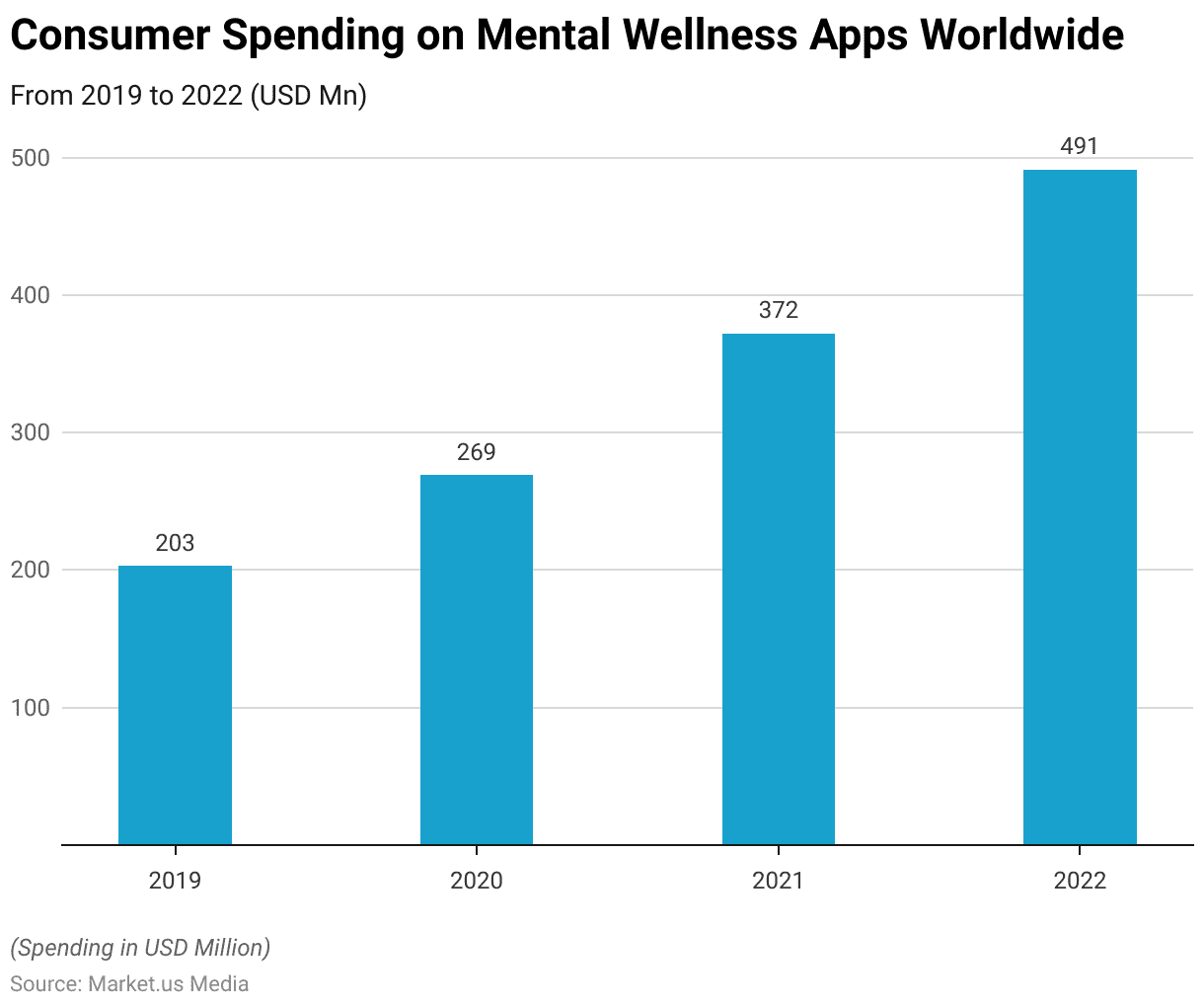
Share of Older Adults with Mental Health Needs
- In 2021, older French adults were more likely to report a mental health need compared to older adults from higher-income countries.
- In the United States, Hispanic adults have higher mental health needs than the French.
This statistic displays the percentage of adults aged 65 and older who reported a mental health need in 2021 worldwide.
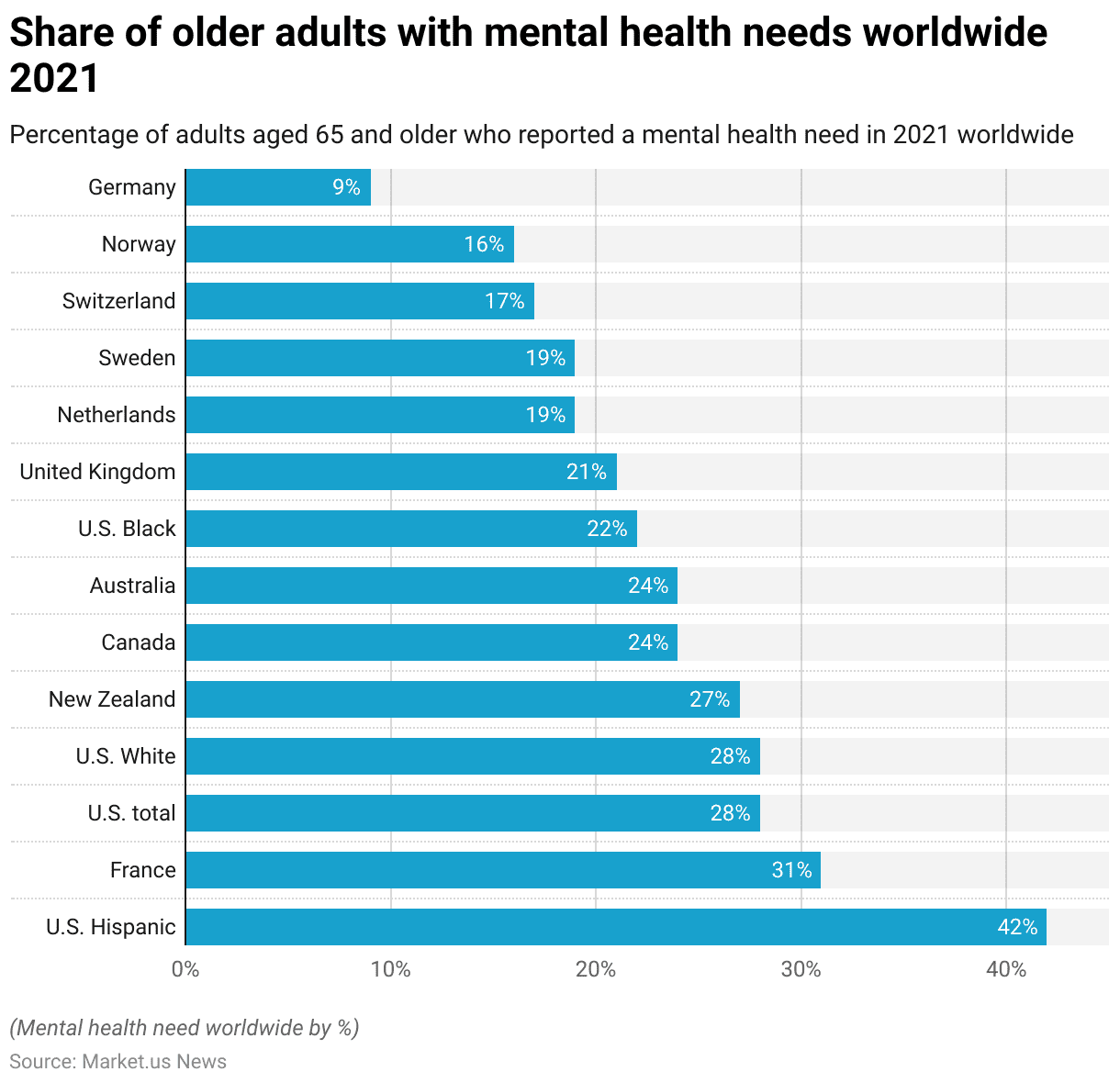
Mental Health Status in Asia
Mental health is a rising global health concern, the prevalence of mental health issues varying according to each country, and cultural factors.
Singapore
- 1 in 7 individuals in Singapore has experienced mental health conditions.
- 1 in 16 people in Singapore has a major depressive disorder.
- 1 in 24 people in Singapore has alcohol abuse.
- 1 in 28 people in Singapore has obsessive-compulsive disorder.
- About 18% of the population in Singapore lives with depression.
- Singapore has the lowest number of psychiatrists and psychologists.
(Source: ourbetterworld)
India
- In 2021, 10% of the population in India has been suffering from one or more mental health conditions.
- India accounted for 15% of the global mental, substance abuse, and neurological disorder burden.
- More than 70% to 80% of individuals suffer from mental illness issues and struggle with treatment.
- According to WHO reports India spent less than 2% of their healthcare budget on mental health.
- 74% of Indians suffered from stress while 88% suffered from some kind of anxiety disorder.
(Source: ourbetterworld, Statista)
Malaysia
- Mental health conditions are the second biggest health problem among individuals in Malaysia.
- About 29.2% of adults in Malaysia aged 16 years and above have any mental health illness.
- The states Kelantan, Sarawak, Sabah, and Kuala Lumpur have the highest prevalence of mental health conditions.
- 1 in 5 adults aged 13-17 years are suffering from depression in Malaysia.
- 59% of respondents aged between 16 and 24 years indicated that they had higher levels of stress and anxiety.
- 34% of respondents aged between 25 and 34 years indicated that they had stress and anxiety.
(Source: ourbetterworld, Statista)
Philippines
- More than 3.3 million Philippines population have a depressive disorder, and have a suicide rate of 2.5% male and 1.7% female per 100,000 persons.
- 57% of the Philippines population actively working on their mental illness.
- 10% of children aged 5-15 years are affected by mental health problems.
- According to WHO, 16.8% of adults aged 13-17 years have attempted suicide at least once.
(Source: ourbetterworld, Statista)
Mental Health Treatment in the US
Treatment of mental health issues can come in many different forms and depend on the type of issues and severity of disorders. The common treatment methods include behavioral therapy, psychotherapy, and support groups.
- In 2021, around 50% of respondents in the United States with a major depressive episode reported they received treatment from a general family doctor.
- 43% of adults in the United States reported that they do not receive mental health services.
- 35% of adults said that they did not know where to go for such services.
(Source: Statista)
The United States Mental Health Issues Statistics
Mental health issues are much like other health issues that can be mild but can also be life-altering, affecting the emotional, social, and psychological well-being of the person.
The common types of illnesses include mood disorders, anxiety disorders, eating disorders, and personality disorders.
- In 2022, it was estimated that around 34% of those in the US aged 18-25 years suffered from some form of mental illness.
- 28% of those aged 26-49 years suffered from some form of mental illness.
(Source: Statista)
How common is depression in the United States?
- Depression is one of the most common disorders in the United States.
- Around 8.3% of US adults reported a major depressive episode in the last year 2022.
- 75% of women aged 18-20 reported major depressive episodes in 2022 compared to 8.6% of women aged 40-44 years.
- Around 32% of those in the US with a major depressive episode in the past year had serious thoughts of suicide compared to just 2% of those who did not have any major depressive episode.
(Source: Statista)
Psychotic Disorders Worldwide
Psychotic disorders are severe mental health disorders that cause changes in a person’s way of thinking. The market values represent the revenue generated.
- The psychotic disorder segment accounted for revenue of USD 3.65 billion in 2023.
- The revenue is expected to show a CAGR of 0.77%.
- The market is expected to reach USD 3.76 billion in 2027.
- Most of the revenue was generated in the United States which is about USD 2,289.0 million in 2023.
(Source: Statista)
Prevalence and Burden of Schizophrenia Statistics
Schizophrenia is a common disease but it can be a serious and chronic one. The term schizophrenia is used to indicate how many people are currently living with a specific condition at or during a particular condition of time.
- About 1% of the global population is diagnosed with schizophrenia.
- Approximately 1.2% of Americans (3.2 million) have schizophrenia disorder.
- About 1.5 million people will be diagnosed with schizophrenia this year around the world.
- Most of the people with schizophrenia disorder are between the age of 16 to 25 years.
- Schizophrenia is one of the top 15 leading causes of disability worldwide.
- The average potential of life lost for individuals with schizophrenia in the United States is 28.5 years.
- About 4.9% of people with schizophrenia disorder die by suicide, the rate of that is greater than the general population, with higher risks in the early stages of illness.
(Source: mental help, nimh.nih)
Primary Mental Health Issues Among US Students 2022
- The primary health concern of college students in the United States, as reported by mental health clinicians, for the academic year 2021-2022 was anxiety.
- Around 24.6% of mental health, clinicians stated that anxiety was the top concern in college students.
- Stress, relationship problems, and family problems are some of the leading mental health issues among college students in the United States.
- 41% of college students reported that they have depression syndrome.
- In 2021, 31% of college students in the United States had been diagnosed with anxiety disorder.
- 27% of college students have been diagnosed with depression or other mood disorders.
- In the academic year 2021-2022, 35% of college students in the United States received mental health treatment.
- About 9% of students who received mental health services have been hospitalized for their mental health concerns.
(Source: Statista)
Percentage of mental health clinicians who stated select issues were the top concerns of their college student patients during the 2021-2022 academic school year (In %)
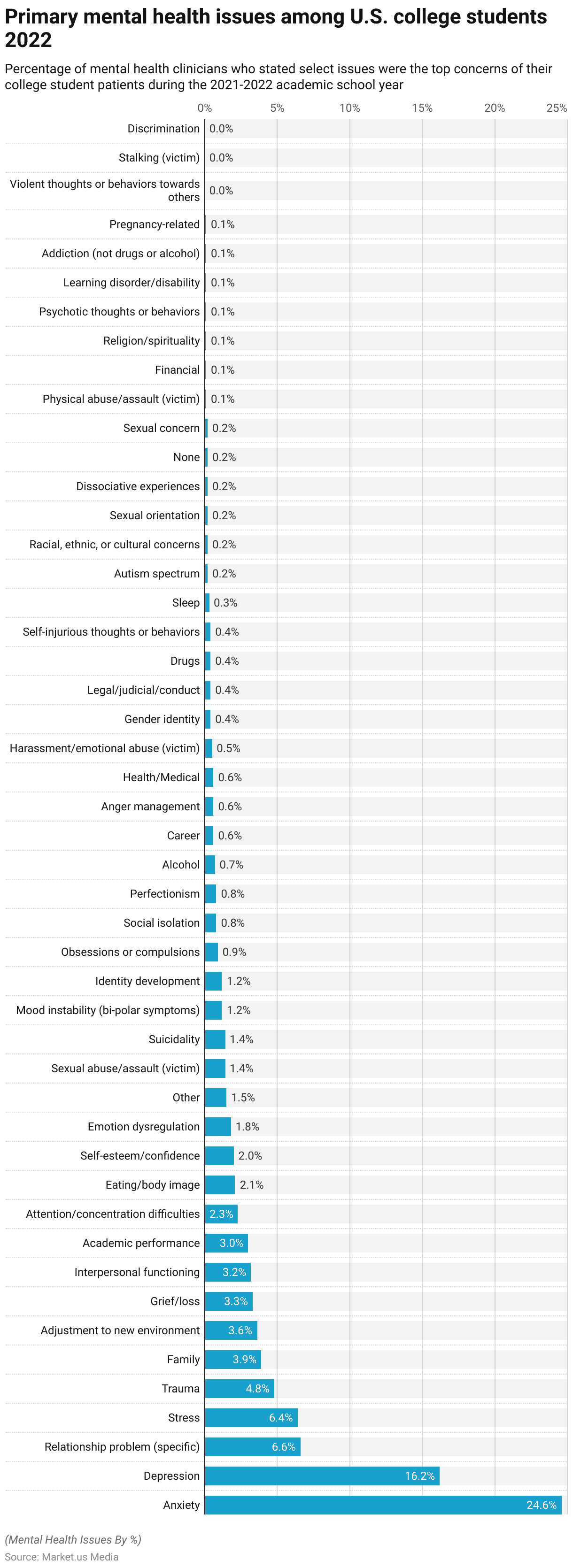
Mental Health Services Challenges in Canada
- According to a survey in Canada in 2022, not enough professionals working in mental health services was seen as a major problem by more than 40% of respondents.
- 36% of respondents felt that it was a significant problem.
- 20% of respondents felt that it was a bit challenging, while 5% of respondents felt that it was not a problem.
(Source: Statista)
Distribution of opinion on the scale of challenges in mental health services in Canada in 2022

Mental Health Practices of Gen Z in Russia 2022
- In the first quarter of 2022, about 6 out of 10 Russian Generation Z representatives practiced positive thinking to maintain their mental health.
- 58% of representatives practice regularly, 20% do not practice but they realize it’s important, and 22% of representatives think that it is not important.
(Source: Statista)
Distribution of mental health practices of Generation Z in Russia in 1st quarter 2022
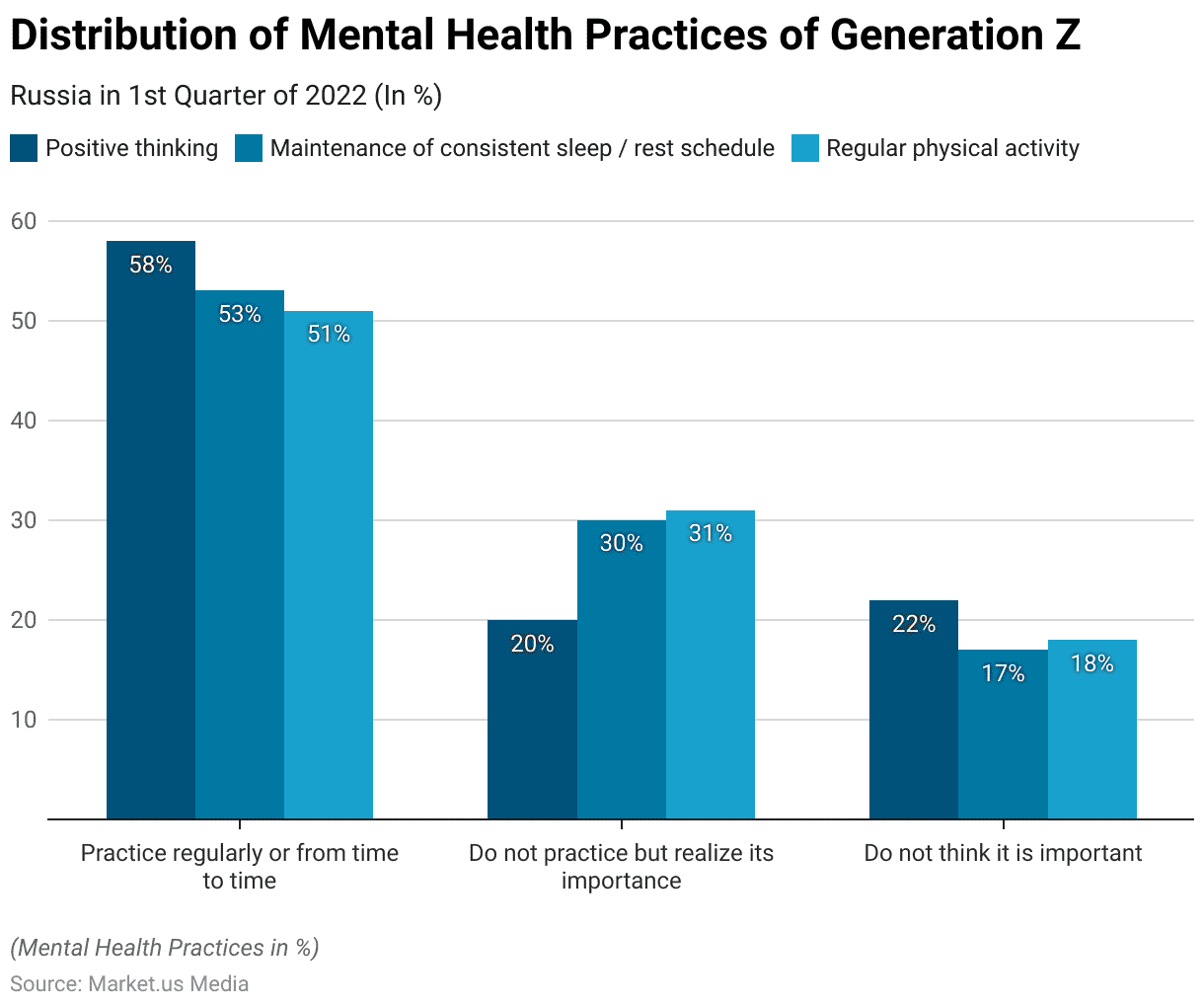
Driving Factors for Mental Health Issues in Indonesia Statistics
- 59% of respondents reported that financial problems are the major trigger in taking treatment for mental health conditions.
- It was followed by loneliness and work pressure, with respondents shares of 46 percent and 37 percent, respectively.
- In the same year, stress and sleep disturbances were found to be among the leading mental health issues experienced by people in Indonesia.
(Source: Statista)
Most common triggers for mental health issues in Indonesia as of September 2022
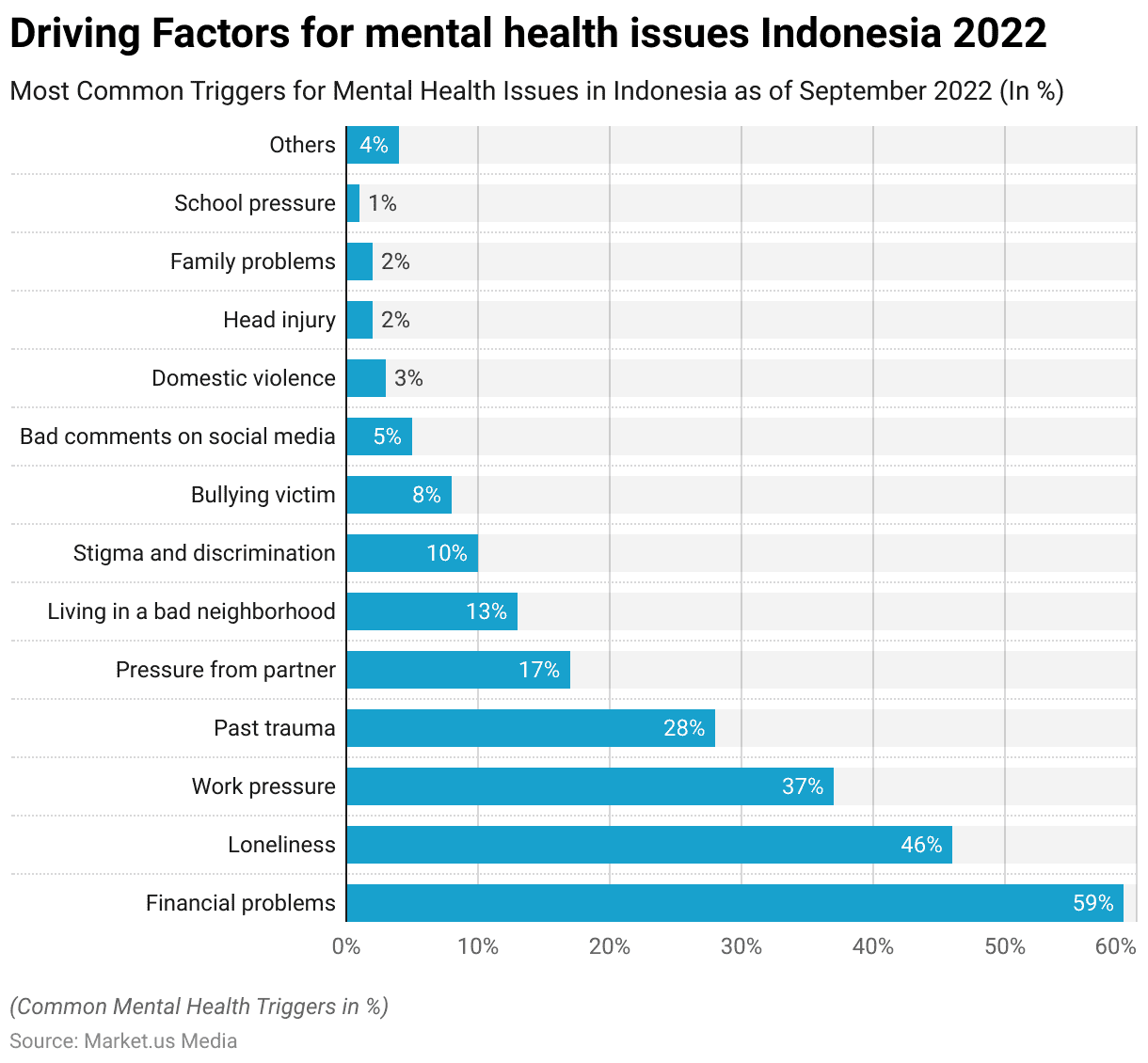
Prevalence of Mental Health Conditions in Brazil Statistics
Stress, anxiety, depression, bipolar disorder, and schizophrenia are some most common mental health conditions in Brazil.
- In 2022, stress was the mental health condition with the highest prevalence among individuals.
- About 47,000 per 1000,000 people are suffering from stress in Brazil.
- More than 8,148.21 per 1000,000 people are suffering from anxiety.
- Depression ranked 3rd with more than 4,289.13 per 1000,000 inhabitants.
- The prevalence of bipolar disorder and schizophrenia was 1,226.68 and 318.95 per 100,000 inhabitants in 2022.
(Source: Statista)
Prevalence of mental health conditions in Brazil as of 2022, by selected category (per 100,000 people)

Cost of Medicines for Treating Mental Health Disorders in Brazil 2022 Statistics
- In 2022, medicines for treating post-traumatic stress disorder (PTSD) had the cost as compared to median global prices for the same drug in Brazil among the categories of medicine for treating mental health conditions, with an estimated deviation of more than 100%.
- Medicine for treating bipolar disorder costs approximately 96% more in Brazil than the global median price.
- Medicine used for depression costs approximately 56.07% more in Brazil than the global median price.
- Medicine used for the treatment of schizophrenia is nearly 4.53% cheaper than the global median price in Brazil.
- Medicines for anxiety are about 5.05% cheaper than the global median price in Brazil.
- Medicine used for the treatment of stress was nearly 10% cheaper in Brazil relative to the global median price.
(Source: Statista)
Share of Young People Who Rate Their Mental Health Positively Australia Statistics
- In 2022, 42.20% of males in Australia rate their mental health and well-being as excellent.
- 22.80% of individuals in Australia reported their mental health and well-being as excellent or very good.
- 12.50% of respondents in Australia reported that their mental health and well-being as excellent or very good.
Share of young people who rate their mental health and well-being as excellent or very good in Australia in 2022, by gender
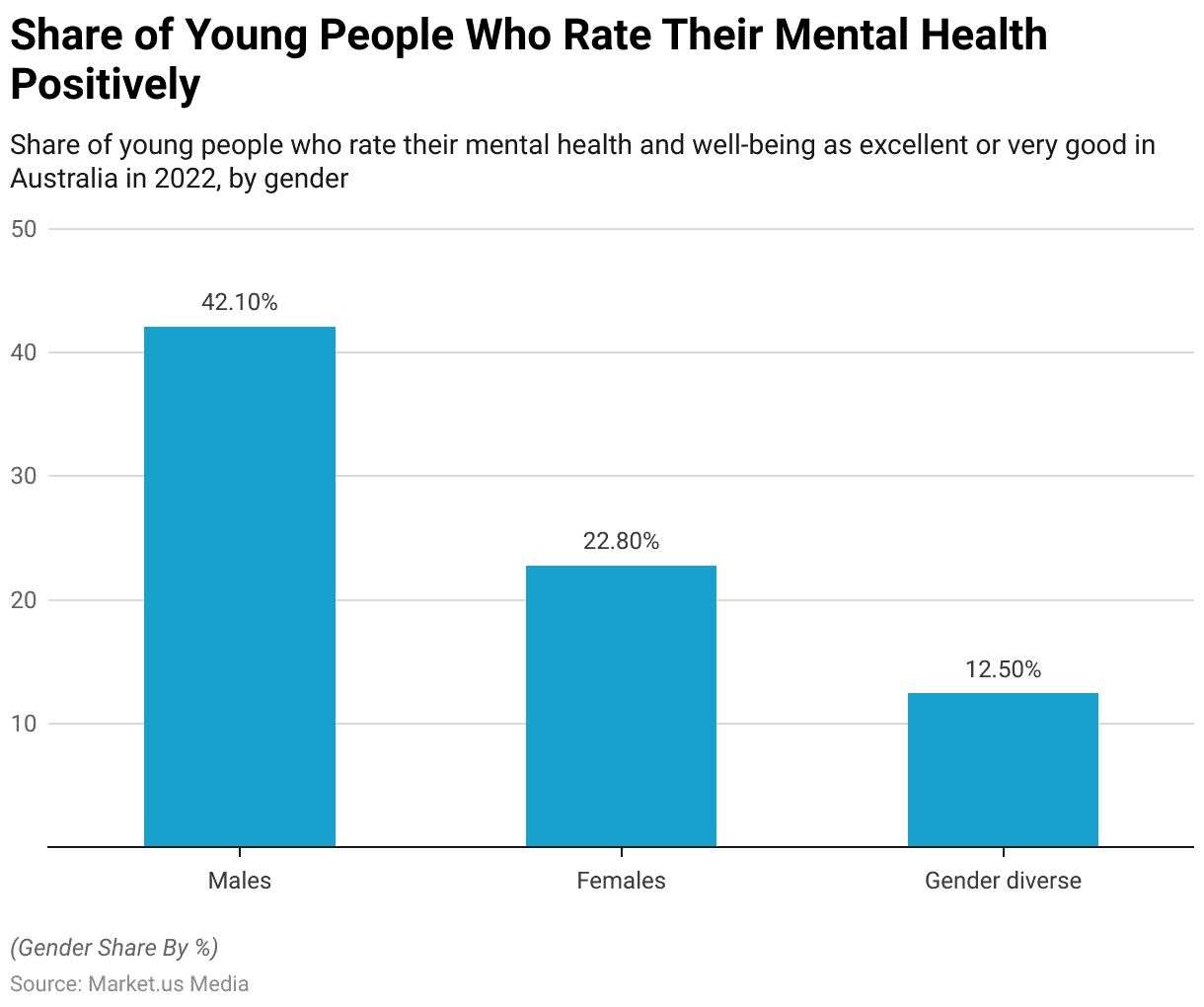
Public Opinion on Mental Health Care in Chile Statistics
- In August 2022, Approx. 86% of individuals indicated that mental and physical health are equally important.
- 65% of respondents reported that mental well-being is very or fairly often important.
- 6 in every 10 Chilean respondents considered mental health as the top health problem people face in South American Countries.
- 42% of respondents reported that physical health is treated as more important in the healthcare system.
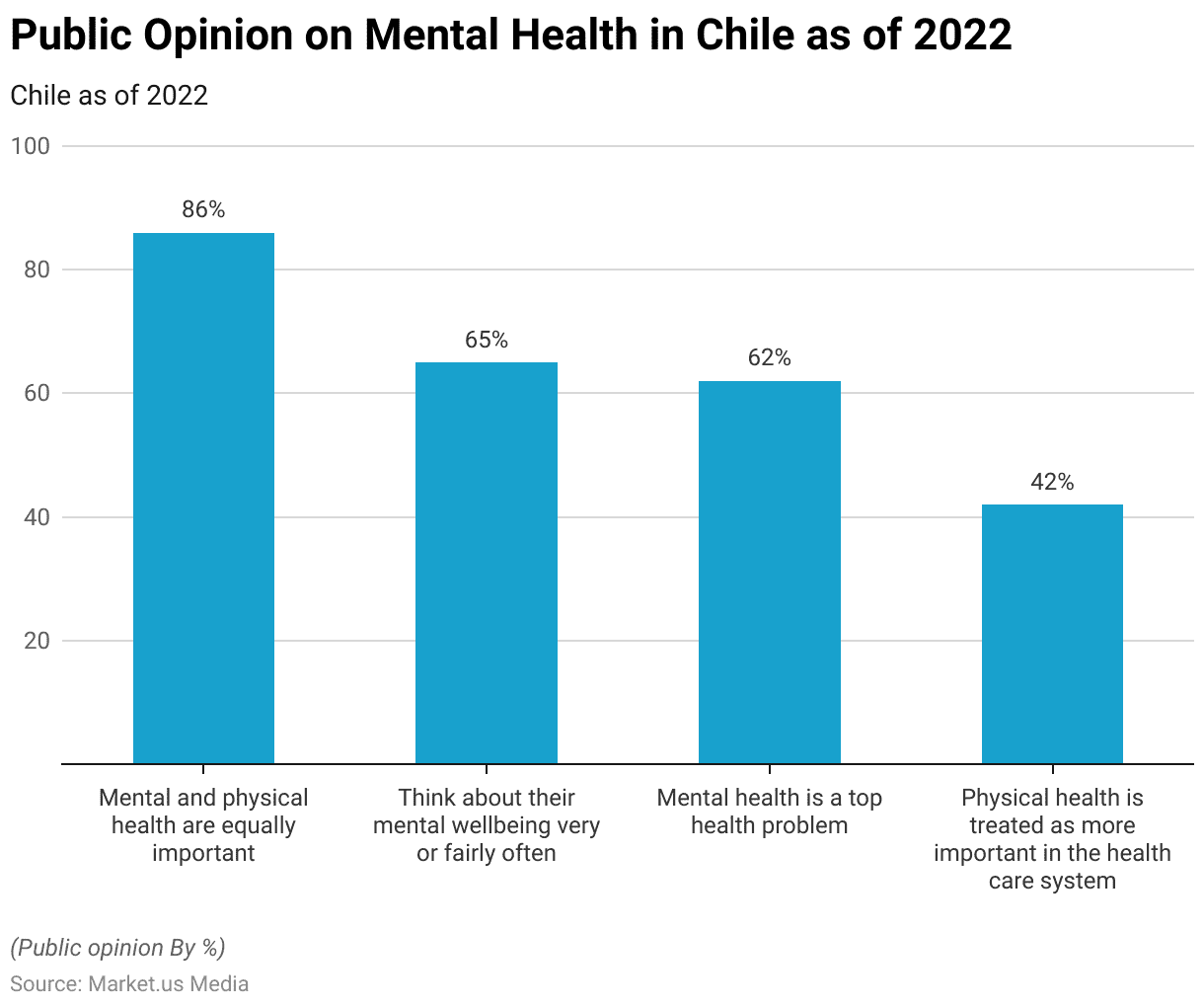
Mental Health Public Opinion in Spain Statistics
- 72% of respondents have reported that mental and physical health are equally important.
- 56% of individuals respond that they think about their mental well-being very or fairly often.
- 51% of respondents reported that mental health is the top health problem.
- 44% of respondents reported that physical health is treated as more important in the healthcare system.
Public opinion on mental health in Spain as of 2022

COVID-19 Impact on Mental Health Statistics
COVID-19 has a significant impact on mental health around the world. Social distancing measures and quarantine have led to increased feelings of isolation and loneliness, particularly among those who live alone. The coronavirus crisis led to increased stigma and discrimination towards certain groups, such as those who have been infected with COVID-19.
- The high percentage of adults who experienced mental illness was 23% in Australia, 26% in Canada, 24% in France, 23% in New Zealand, 26% in the United Kingdom, and 33% in the United States.
- The lower rate of mental illness is seen at 14% in the Netherlands, 10% in Norway, and 18% in Sweden.
- A WHO survey in the second quarter of 2020 found that more than 60% of countries worldwide reported disruption in mental health services.
- In 2020, 14% of community mental health centers have been closed.
- 19.7% of individuals were suffering from anxiety.
- 14.2% of individuals have a sleep disorder.
- 13.7% of individuals have high-stress issues.
- 4.2% of individuals were suffering from eating disorders.
- 13% of Americans began using substances to deal with pandemic-related stress.
(Source: OECD, NIH)
Several countries across the globe approach overcoming COVID-19-related disruption in mental health, neurological, and substance abuse (MNS) related services.
Share of Countries with Approaches to COVID-19 Mental Health Support During the Pandemic Statistics
- 70% of countries across the globe adopt telemedicine/teletherapy deployment to replace in-person consultations.
- 67.70% of countries established helplines for mental health and psychological support.
- 65.40% of countries provide specific measures for infection prevention and control in mental health services.
- 53.80% of countries approach self-help or digital format of psychological interventions.
- 44.60% of countries trained their COVID-19 healthcare providers in basic psychological skills.
Approaches to overcome COVID-19 related disruption in mental health, neurological, and substance abuse (MNS) related services worldwide as of 2020
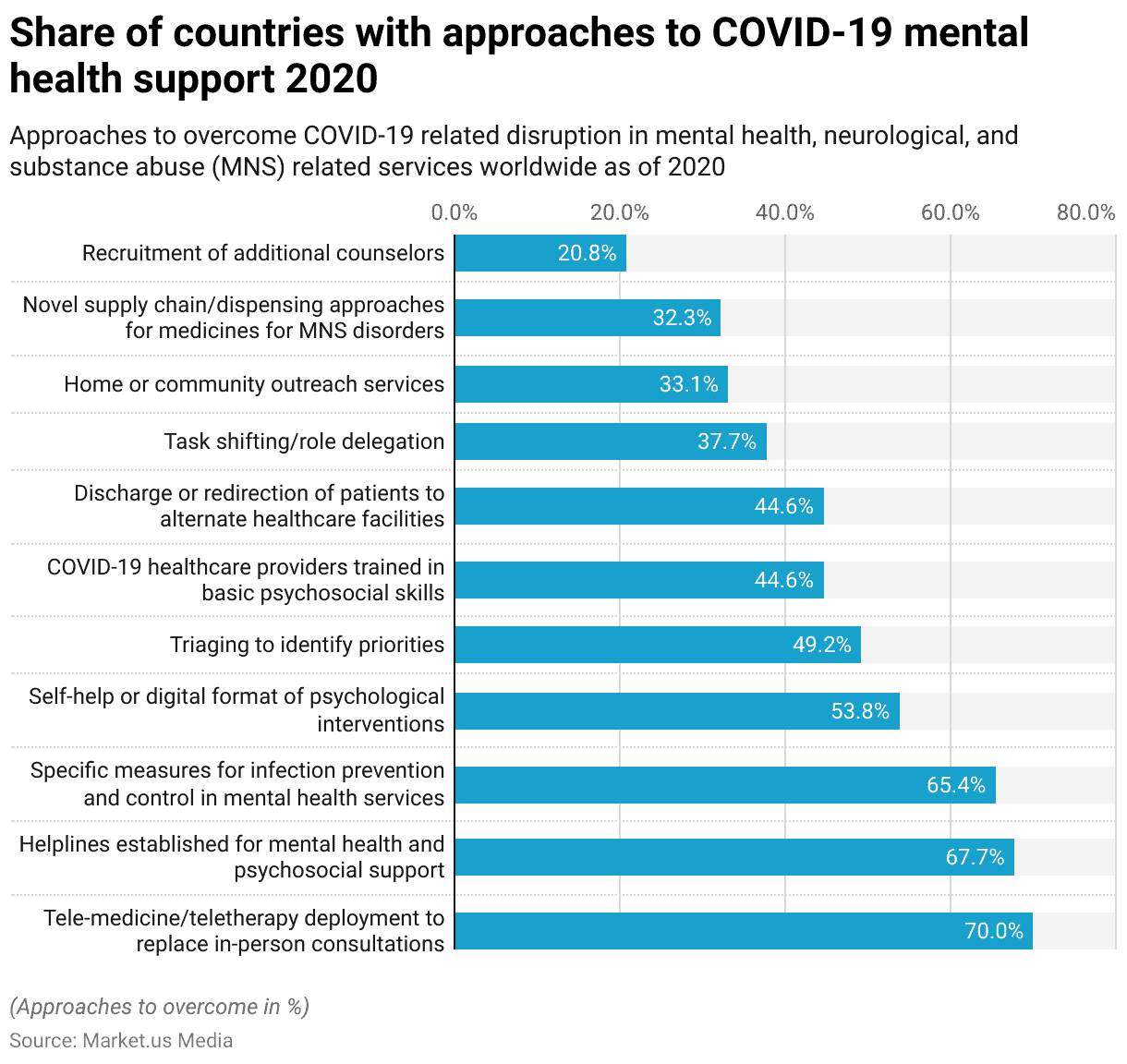
Recent Developments
Acquisitions and Mergers:
- MentalHealth Solutions acquired TherapyTech for $80 million, expanding its portfolio of online therapy platforms and increasing its market share in the digital mental health sector.
- WellnessGroup merged with MindfulCare, forming a comprehensive mental health services network with combined revenues projected to exceed $300 million annually.
New Product Launches:
- MoodTracker introduced a mood-tracking app with customizable features for users to monitor their emotional well-being, targeting 1 million downloads within the first year.
- MindfulnessNow launched a meditation and mindfulness app offering guided practices and relaxation techniques, aiming to reach 500,000 subscribers within six months.
Funding Rounds:
- MentalWellness received $50 million in Series B funding led by Venture Capital Firm XYZ to enhance their mental health platform’s features and expand into new markets, targeting a 50% increase in user engagement within the next year.
- TherapyLink secured $30 million in seed funding from Tech Investors ABC to scale up user acquisition efforts and invest in AI-powered tools for personalized mental health recommendations, aiming for a 40% growth in active users.
Consumer Trends:
- Rising awareness of mental health and destigmatization efforts led to a surge in demand for mental health services, with therapy appointments increasing by 30% compared to the previous year.
- Millennials and Gen Z individuals showed a preference for online therapy platforms, with teletherapy sessions witnessing a 35% growth in usage among younger demographics.
Regulatory Landscape:
- Regulatory bodies implemented telehealth regulations to ensure the quality and safety of online therapy services, including guidelines for therapist licensure and patient confidentiality, fostering trust in virtual counseling platforms.
Wrap Up
Mental Health Statistics – Good mental health is essential for a healthy and fulfilling life, and it allows us to enjoy the pleasure of life and manage the challenges that come our way.
The COVID-19 pandemic surged the demand for mental health, as it had a significant impact on mental health across the globe.
Individuals’ lifestyles are continuously changing across the globe, which is leading to the emergence of severe mental health issues.
It is also essential for governments and communities to invest in mental health services to support the healthcare system to address the growing need for mental health resources.
By working together to prioritize mental health, it is possible to promote overall well-being and create healthier and more resilient communities.
FAQs
Mental health is essential to our well-being and quality of life. It refers to our psychological, emotional, and social well-being and affects how we think, feel, and behave. It plays an important role in our ability to cope with stress, form relationships, and make decisions.
According to the World Health Organization (WHO), one in four people globally has any mental health disorder for a lifetime and it is the leading cause of disability worldwide.
The most common mental health disorders include anxiety disorders, depression, bipolar disorder, schizophrenia, and eating disorders.
Discuss your needs with our analyst
Please share your requirements with more details so our analyst can check if they can solve your problem(s)



